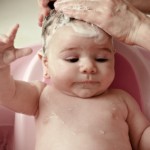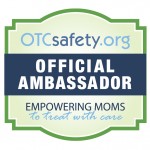 Babies come with their own unique set of dermatologic conditions that can baffle any new parent. Whole books have been devoted simply to recognizing and treating (or not) the myriad of skin conditions and birth marks we often see popping up on their newborn delicate skin.
Babies come with their own unique set of dermatologic conditions that can baffle any new parent. Whole books have been devoted simply to recognizing and treating (or not) the myriad of skin conditions and birth marks we often see popping up on their newborn delicate skin.
The good news is, most newborn skin conditions are harmless and bother us more than our beautiful babies. And fortunately, the majority resolve on their own, so the only treatment necessary is time and a little patience on our part.
This is particularly true of cradle cap, aka infantile seborrheic dermatitis…yeah, say that to your pediatrician the next time you think your baby has a case of this.
What does cradle cap look like?
Often, a parent will bring their baby into clinic really worried about a thick, white to yellow, scaly plaque or patches on their baby’s head. The baby could care less and is happy and thriving.
In other circumstances, the baby’s scalp can simply look dry and flaky. The appearance can vary from one baby to another. In addition, the cradle cap can often extend to the baby’s forehead and sometimes will appear as redness in skin creases such as behind the ears, in the armpits, and/or in the neck folds. In these cases, we call that seborrheic dermatitis.
The important thing to note is the baby is not bothered by it. It doesn’t hurt, is not itchy, and is not caused by poor hygiene or allergies. This is in contrast to eczema, which is itchy, can be more widespread (on cheeks, arms/legs, and scalp), and is often exacerbated by food and/or environmental allergies.
Why does my baby have cradle cap?
Cradle cap is extremely common in newborns and may persist in some cases, up until the child is 3 years old! It tends to run in families and is believed to be influenced by maternal hormones.
While no exact cause has been identified, we think what happens is that the oil glands on the scalp (hair follicles) produce an excess of oil (also called sebum). This oil can clog those hair follicles, causing a buildup of skin cells and oil. Thus, you get that yellowish scale and in milder cases, the white flaky skin.
Again, keep in mind it’s not due to poor hygiene or allergies
What can I do about it?
Considering this is a non-infectious, non-contagious skin condition that really bothers us parents more than our babies…the best treatment is time.
However, there are some simple things you can do to hasten the process. Try washing your baby’s scalp daily with a mild baby shampoo. While cleaning, massage the scalp gently with a washcloth, then rinse. Gently brush baby’s scalp with a soft brush to remove some of the scales. It’s important to keep in mind that while you’re washing baby’s scalp daily, her body may not need it, as daily bathing can quickly dry out a newborn’s delicate skin.
Once most of the scales have disappeared, you can resume only shampooing hair/scalp twice a week.
Some other home remedies include the use of mineral or olive oil. Apply to areas with thick plaques and let it sit in for a few minutes. Then massage gently to remove some scales. Be sure to shampoo and rinse thoroughly after this, as any residual oil can potentially worsen the condition by further clogging those hair follicles.
Other treatments
In cases of more severe or persistent cases, you may want to ask your pediatrician about medicated shampoos or lotions that contain sulfur or 2% salicylic acid. These must be used with great caution and again, would only use for very bothersome cases.
At times, some babies may experience redness and inflammation of the scalp due to cradle cap. In these cases, your pediatrician may want to use hydrocortisone cream to calm it down.
The bottom line is that cradle cap is extremely common, is typically nothing to worry about and aside from it not being pleasing to the eye, is harmless and will resolve on its own.
So enjoy your beautiful baby and take comfort in the fact that in the case of cradle cap, the best treatment is time.
Did/does your baby have cradle cap? How did you treat it? Any questions about cradle cap?
Keep an eye out for more Baby Skin 101 topics and check out this post about a few other common newborn skin conditions.
Pin It








Yes! I had to focus my “picking” on something else! All I wanted to do was pick it out…and that bothered him more then the icky cradle cap! My bean had it off and on for a year. Glad that is over!
My son had it up until he was 2. I was still picking out little chunks at that age…but then…it went away It really is more bothersome to us than to them!
It really is more bothersome to us than to them!
My twins both had cradle cap and I did not like it at all. When it spread all over their heads, I did the oil and comb thing and the only result I got was their hair fell out in clumps.
I used a lot of products but in the end, time was really all it needed to clear up. One baby still has a dime sized patch but the other baby is good. I think due to difference in hair type, cradle cap in babies may require different treatments based on ethnicity.
My cradle cap treatment post is at http://www.mytwintopia.com/2011/06/treating-cradle-cap.html